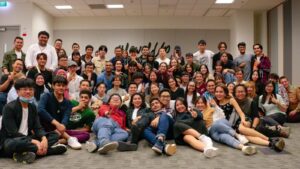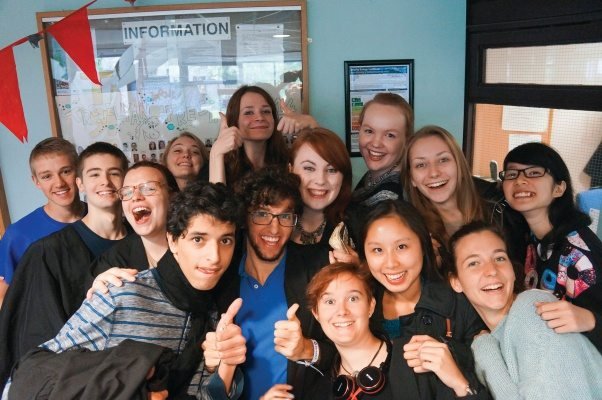The International Student Community’s various threads are woven into the rich fabric of academia. In a time of globalization, the flood of students traveling across borders to further their education has made learning vibrant and stimulating in academic settings all around the world. The International Student Community fosters a special fusion of global intelligence and fellowship by representing a diversity of cultures, languages, and perspectives. These students set out on a trip that crosses national borders in search of education, cross-cultural interaction, and personal development.
The International Student Community develops into a microcosm of common experiences and understanding as they negotiate the complexities of a foreign educational environment. This introduction lays the groundwork for a discussion of the difficulties, victories, and priceless contributions made by the International Student Community, a group that infuses educational institutions with a global flavor and leaves a lasting impression on the academic scene.

Embracing Diversity: The International Student Community’s Dynamic Impact in Academic Settings
Academic institutions now function as melting pots of cultures, viewpoints, and experiences thanks to the globalization of education. The International Student Community, a lively and diverse cohort that profoundly enriches the academic environment, is crucial to this transforming landscape. The multifaceted effects of the International Student Community on academic institutions are examined in this article, along with their importance, contributions to cultural diversity, common problems encountered, specialized support services, influence on the educational process, and steps toward inclusivity and integration.
The International Student Community’s Significance
Not just an add-on to the academic setting, the International Student Community is a vital force for improvement and enrichment. Its importance stems from its capacity to establish an international learning environment, dismantling cultural barriers and promoting a sense of interconnectivity. With students from various backgrounds, customs, and viewpoints, academic institutions take on the characteristics of small-scale global communities. The quality of education is improved by this international interchange of ideas, which equips students for a workforce that appreciates cultural competency and diversity.
A Contribution to Diversity in Culture
The International Student Community has made incalculable contributions to the cultural diversity of academic institutions. Imagine you are in a lecture hall with students from Asia, Europe, Africa, and the Americas. Every learner carries a cultural lens with them that shapes how they approach learning and solving problems. This diversity gives local students a special chance to interact with perspectives from around the world without having to leave campus, in addition to enhancing the educational experience for international students.
Students from various cultural origins may provide creative solutions affected by their cultural experiences, for instance, during a collaborative assignment. By questioning conventional wisdom and broadening the students’ collective intellectual horizons, this intellectual interchange creates a rich learning environment.
Read Also: How Get Paid to Watch YouTube Videos in 2023
Typical Obstacles Faced by Foreign Students
Although the International Student Community makes a positive impact on academic life, studying overseas presents a common set of difficulties for its members. Language problems can make it difficult to communicate effectively, which can inhibit social and academic integration. One common feeling of cultural shock is having to navigate new social norms and become used to various teaching philosophies. International students endure additional difficulties due to homesickness, complicated visa procedures, and limited funds.
Consider a student from a non-English speaking nation who finds it difficult to communicate intricate concepts in a foreign language. The need for specialized aid for the International Student Community is highlighted by the possibility that this student will need additional language help and resources to close the gap.
Personalized Resources and Support Programs
Academic institutions all over the world have put in place focused programs and resources to enable a seamless transition and a rewarding academic experience in recognition of the special demands of the International Student Community. Orientation programs aim to furnish vital details regarding cultural subtleties, support services, and academic requirements. Programs for language aid address the linguistic difficulties faced by overseas students by providing targeted tutoring and language instruction to improve proficiency.
The emotional and psychological challenges of studying abroad are also addressed by counseling programs designed specifically for the International Student Community. With the use of these resources, an environment that is supportive of international students’ academic achievement is fostered, acknowledging and addressing the unique obstacles that they encounter.
Effect on the Entire Educational Process
Beyond individual experiences, the International Student Community has a substantial impact on the general learning environment for both domestic and foreign students. A wide range of viewpoints is beneficial for group discussions, cooperative projects, and classroom interactions. Because of this diversity, which questions the current quo, students are inspired to think critically and approach issues from several perspectives.
Imagine a situation where students with backgrounds in business, engineering, and cultural studies collaborate on a group project. The foreign students bring a comprehensive approach to problem-solving, molded by their distinct cultural settings. In addition to improving the educational process, this collaborative learning approach equips students with the critical abilities of adaptation and cross-cultural cooperation in an increasingly globalized workforce.
Strategies for Integration and Inclusivity
A helpful and inviting academic atmosphere can only be achieved by fostering inclusivity and integration within the International Student Community. Students can share and learn from one other’s cultural history through international festivals, cooperative projects, and cultural exchange events. A sense of connection and belonging is fostered by student organizations committed to the International Student connection.
For example, a university might plan an annual International Day event when students perform traditional dances, sing songs, and share food from their cultures. This gives local students a chance to interact with and pick up knowledge from their classmates in addition to enabling international students to share their heritage. Mentorship programs that match local mentors with overseas students help with integration by providing advise on academic issues, cultural adjustment, and personal concerns.
Read Also: List Of 5 Steps On How To Use The Internet To Get Dental Temps
Additionally: International Student Community
In academic institutions, the International Student Community has a transforming effect that adds to the worldwide nature of education. Its importance is found not only in the variety of cultures it brings, but also in the obstacles it surmounts and the overall effect it has on education. Academic institutions’ dedication to providing a comprehensive and enriching educational experience for every student is demonstrated by their use of inclusive measures, collaborative learning initiatives, and tailored support services.
The International Student Community is proof of the value of variety in education as we negotiate the challenges of a globalized world. Academic institutions will become furnaces of comprehension, empathy, and cooperation as well as knowledge hubs if they embrace and celebrate this diversity.
Academic Institutions’ International Student Community: Significance
Due to its role in creating a globalized learning environment, the International Student Community is of the utmost importance in academic institutions. The presence of students from varied cultural backgrounds broadens the viewpoints of faculty members and fellow students, enriching the academic conversation as the world grows more interconnected. Within the academic realm, the International Student Community is a living example of the value of cross-cultural exchange and the universality of knowledge.
A Contribution to Diversity in Cultures
The International Student Community has made significant and varied contributions to the cultural diversity of learning environments. The diversity of customs, languages, and viewpoints that these students bring to the university results in a melting pot of cultures.
The inclusion of varied cultural components improves the educational process as a whole and inspires students to converse across cultural boundaries, extend their perspectives, and become more sensitive to other cultures. To put it simply, the International Student Community serves as a vital catalyst for the development of a global attitude among all academic staff.

Typical Obstacles Faced by Foreign Students
Even though the International Student Community is very beneficial, studying abroad presents its members with a number of similar obstacles. Academic achievement and effective communication might be hampered by language problems. It can also be intimidating to adjust to new social dynamics, cultural standards, and educational systems.
Another layer of complexity is the distance from usual support networks and relatives. The difficulties faced by overseas students are exacerbated by financial limitations and problems pertaining to visas. Notwithstanding these obstacles, the International Student Community’s members’ perseverance and resilience in overcoming these difficulties highlight their will to succeed in an academic environment that is new to them.
Support Resources and Programs
Many academic institutions have put in place specialized programs and resources to offer customized support in response to the particular needs of the International Student Community. International students can benefit from orientation programs, which provide information about academic standards, cultural quirks, and accessible resources to assist them adjust to their new surroundings. Tutoring services and language aid programs are frequently offered to improve academic performance and language competency.
The International Student Community has a variety of obstacles, and cultural exchange programs, mentorship programs, and counseling services all work to address these issues and foster a sense of belonging within the academic community.
Effect on the Entire Educational Process
Beyond any one of its members, the International Student Community has a profound effect on the general educational experience of both domestic and foreign students. An academic community that is more inclusive and tolerant is fostered by exposure to varied viewpoints. A multitude of perspectives originating from various cultural contexts are beneficial to collaborative projects and group discussions, enhancing the educational process. Engaging with global peers facilitates the development of crucial competencies including cross-cultural communication and international teamwork, equipping all students for the interconnectedness of today’s workforce.
Read also: International Education Events
Strategies for Integration and Inclusivity
Academic institutions implement diverse strategies to foster inclusivity and integration among the International Student Community. International fairs, multicultural festivals, and cultural exchange activities provide a forum for students to share and learn from one another’s customs. A network of support and connections is made possible by student groups and clubs that are expressly devoted to the International Student Community. Furthermore, mentorship initiatives match overseas students with local peers, creating significant connections that facilitate the adjustment and strengthen the campus community. Taken together, these actions support an academic climate that is more integrated and inclusive.
In addition to enhancing the cultural diversity of academic institutions, the International Student Community is a key component of globalized education. Academic institutions have put in place focused programs and resources to assist these students’ needs and improve everyone’s overall learning experience because they understand how important these students are. The continuous endeavors to foster inclusiveness and assimilation within the International Student Community emphasize the dedication to establishing an authentically worldwide and interlinked educational milieu.
Trust you found our article on International Student Community helpful. Follow our website for more interesting articles.
